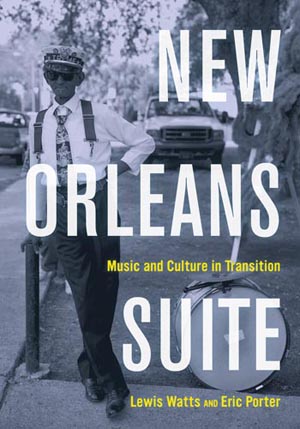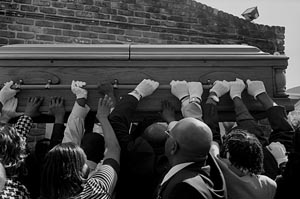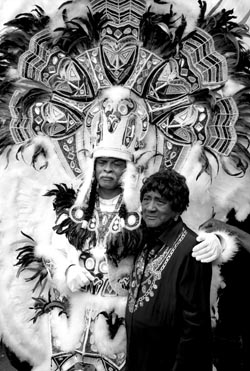Campus News
UCSC arts, humanities professors collaborate for ‘New Orleans Suite’
A new book by UCSC professors Lewis Watts (Art) and Eric Porter (History, American Studies) maps the changing cultural scene in New Orleans since Hurricane Katrina hit the Crescent City in the summer of 2005.






A new book by UCSC professors Lewis Watts (Art) and Eric Porter (History, American Studies) maps the changing cultural scene in New Orleans since Hurricane Katrina hit the Crescent City in the summer of 2005.
New Orleans Suite: Music and Culture in Transition (UC Press 2013) provides a window into the social life of New Orleans—both before and after the devastating hurricane.
“New Orleans Suite is not merely a book about Katrina,” says Porter, author of the award-winning 2002 book What is This Thing Called Jazz?
“Through Lewis’s photographs and my written sections, we consider how the storm was both a transformative force and a vehicle that enabled longstanding processes to come into view.
“We’re particularly interested in ways black culture—especially music—has been mobilized to reconstruct the city post-Katrina, for better and for worse.”
Porter notes that the focus on celebrating the value of New Orleans’ unique musical culture has sometimes drawn attention away from other pressing issues—such as the exploitation of musicians and other low-wage workers, or the conversion of public housing into mixed-use developments.
“We continued to see such contradictions as we contemplated the city’s renewal in the years after Katrina,” Porter observes.
He adds that while young professionals have recently moved to the city, many people who lived in New Orleans prior to the storm remain displaced.
“Many residents—especially in the city’s lower income areas—have had to deal with a high crime rate, public schools of poor quality, joblessness, and unreasonable rents, as much housing still remains blighted or vacant,” says Porter.
The book employs Watts’s black and white photography to expose the contrast of devastation and humanity at the epicenter of New Orleans.
“New Orleans has a patina that reflects history, climate and culture which attracted me long before Katrina altered the landscape,” says Watts. “There are expressions of culture here that happen nowhere else in the world.”
Watts’ research examines the cultural landscape in rural and urban African American communities.
He is co‐author of Harlem of the West, The San Francisco Fillmore Jazz Era, which consists of found photographs and oral histories of an African American community in the Bay Area that was “urban renewed” out of existence in the late 1960s.
“Like many photographers, I’ve always been attracted to the way Louisiana looks and feels, its unique culture, and its strong artistic tradition,” says Watts.
“Louisiana has a terrible environmental legacy that has most affected its poorest residents, and events after the hurricane underscored the racial and economic divide as well,” he adds. “In Louisiana, like much of the South, the past is never very far below the surface in terms of race, economics, and aesthetics.”
Back in 2005, Watts had planned to do an artist-in-residency in New Orleans at the Ogden Museum of Southern Art, but Hurricane Katrina derailed that plan.
However, he did manage to get to the city six weeks later.
“At first, the damage was overwhelming and more extensive than any of the photos I’d seen,” Watts says. “I began taking photographs, but after a while, I had to stop, because I realized the missing ingredient was people; everyone had left the city.”
“Obviously Katrina is an important part of the story of New Orleans, but for me it is more of a frame of reference,” adds Watts. “It’s really the people, the culture—both before and after Katrina—and the efforts at renewal, that draw me to photograph there.”
Porter and Watts took the title of their book from a composition by Duke Ellington that was commissioned for the first New Orleans Jazz and Heritage Festival in 1970.
“In his suite, Ellington tried to give his impressions of particular places in New Orleans, like Bourbon St; cultural practices like second line parades; and important artists who hailed from there, such as Louis Armstrong and Mahalia Jackson,” says Porter. “We’re trying to do something similar through our photographs and prose.”
The two professors also used the idea of a “suite” as a model for a collaboration that is somewhat different from what often happens between photographers and writers.
They wanted to avoid an arrangement where Watts’s photographs would merely illustrate Porter’s written text, or Porter’s writing would merely explain Watts’s photographs.
“The photographs and essay sections unfold like a musical suite, informing and building from one another but remaining distinct pieces,” Porter notes. “So in this sense, the book works like a suite of computer programs that can share data but do different things with it.”
“And the other way to think of this is as a jam session—where each of us riffs off of ideas put out there by the other person.”